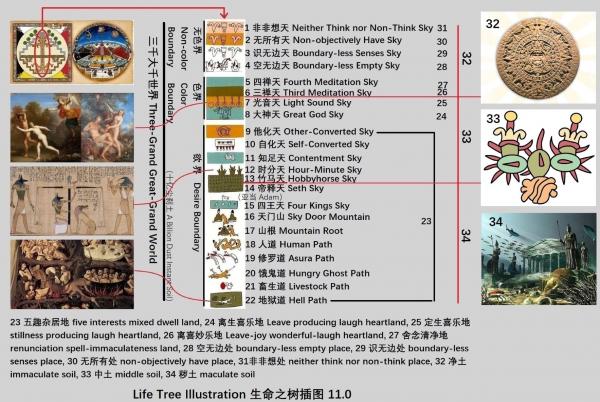| 11.4.2-3 受蕴和想蕴 Acceptance Node and Think Node |
| 送交者: 卢岩 2023年06月29日05:38:12 于 [教育学术] 发送悄悄话 |
11.4.2 受蕴 Acceptance Node受是心地法(参见后文的心所有法)之一的受法,是领纳的感受,接收义。能接收的是人,而所接收到的是受。受蕴是有情眼耳鼻舌身意六识对苦乐等受习气的积聚体总和。 Acceptance, means “the act of taking or receiving something offered”, is one of “omnipresent heartland laws” (detailed explanation refers to Migration Node). The capable of receiving is human; the being received is “the feeling state of being received”. Sentient eye, ear, nose, tongue, body, and Intent-sense (i.e., consciousness), the six senses, each has an accumulative body of laugh, bitter etc. receiving habits; Accepting Node is the sum of the six receiving karmic bodies (i.e., six accumulated bodies of receiving habits).
受能生起欣求的爱欲,有五种:苦受、乐受、忧受、喜受、和舍受。 Acceptance can generate desire for love, can be sorted into five categories: bitter acceptance, laugh acceptance, renunciative acceptance, gloomy acceptance, delightful acceptance. (1) 苦受,领受违逆境相时,身心受到逼迫,以身识作为心来说,这逼迫名苦受。 Bitter Acceptance, when receiving adverse environment, body and heart feel being forced; with body-sense as heart (i.e., mind), the “feeling of being forced” is Bitter Acceptance. (2) 乐受,领受适顺境相时,身心适悦,以身识作为心来说,这适悦名乐受。 Laugh Acceptance, when receiving suitable or beneficial environment, body and heart are pleased, delighted; with body-sense as heart, the happiness is named as Laugh Acceptance. (3) 忧受,领受违逆境相时,身心受到逼迫,以意识作为心来说,这逼迫名忧受。 Gloomy Acceptance, when receiving adverse environment, body and heart feel being forced; with Intent (i.e., preconscious) as heart, the “being forced” is named as Gloomy Acceptance. (4) 喜受,领受适顺境相时,身心适悦,以意识作为心来说,这适悦名喜受。 Delightful Acceptance, when receiving adoptable or beneficial environment, body and heart are pleased, delightful; with Intent (i.e., preconscious) as heart, the “enjoyable delight” is named as Delightful Acceptance. (5) 舍受,领受中庸境相时,于身心非适悦非逼迫,名不苦不乐受,即是舍受。因为人遇到不苦不乐受的中庸感受时,总是选择放弃、离开,所以此种受被命名为舍受。 Renunciative Acceptance, when receiving neutral, neither adoptable nor adverse environment, body and heart are neither enjoyable delightful nor being forced, that is named as “neither bitter nor laugh acceptance”, what Renunciative Acceptance is. Because when a human meets “neither laugh nor bitter acceptance”, the neutral feeling, intents to abandon, gives up, leaves, therefore, the kind of acceptance is named Renunciative Acceptance. 眼耳鼻舌身,这前五识与乐受、舍受、和苦受相应。第六识(意识)与这五种受都相应。第七识(即前意识、末娜、玉女、夏娃)与忧受、舍受、和喜受相应。无意识(古作神识)只与舍受相应,不与其它四受相应。 Eye, ear, nose, tongue, and body, the first five senses match Laugh Acceptance, Renunciative Acceptance, and Bitter Acceptance. The sixth sense (i.e., Intent-sense, consciousness) matches all the five kinds of acceptances. The seventh sense (i.e., Intent, preconscious, Eve sense, Jade-girl sense, Mana sense) matches Gloomy Acceptance, Renunciative Acceptance and Delightful Acceptance. The eighth sense (i.e., unconscious; God-sense) matches to Renunciative Acceptance only which principle is put into great usage in Buddhism. 11.4.3 想蕴 Think Node想是心地法之一的想法,以取像为性,能生成心的内环境,对种种言说的生起有促进作用。想蕴是眼耳鼻舌身意,这六种识的想习气积聚体的总和。总体来说,想有二种,有相想和无相想。 Think is one of six “omnipresent heartland laws”, its nature is to “fetch image”, can generate the inner environment of the mind, and promotes the emergence of various speeches. Think Node is accumulative sum body of the eyes’, ears’, nose’s, tongue’s, body’s, and preconscious’ thinking habits. There are two kinds of think: Image Think, and Non-Image Think. 一、有相想,是能够取境界相状,随起种种言说的一切想,具有明了和分别两种意义。有相想中又有种种差别,约所依根可以分为眼触所生想,耳触所生想,乃至身触、意触所生想等六种。约境界可以分为欲界(如插图所示,或参见第13章的苦谛)想、色界想、和无色界想等差别。 Image Thinks are thinks in state of capable fetching images to form inner environment, and accordingly arousing with various speeches, which has two meanings of clarity and discrimination. Among Image Thinks, there are differences; according to roots, the Thinks can be divided into six kinds: think aroused from eye, think aroused from ear place, think aroused from nose place, think aroused from tongue place, think aroused from body place, think aroused from Intent place (i.e., preconscious). From environmental boundaries to say, Image Thinks can be divided into the “desire boundary (the concept refers to illustration or chapter 13 Bitter Crux) thinks”, “color boundary thinks”, and “None-color boundary thinks”. 二、无相想,就是能缘心上或所缘境上,缺明了或缺分别,或二种俱缺;复有三种:不善言说想,无相界定想,有顶想。 Non-Image Think, that is absent of clarity, discrimination, or both, on the capable heart to aggregate, or on the being aggregated environment. Generally, Non-Image Thinks can be divided into the three kinds: non-talkative think, non-image-boundary still think, have-summit think. (1)不善言说想,如欲界的婴儿等,因未学语言,在缘色等境界的时候,虽然境界有相,但不能分别了解它为色等,故名无相想。 Non-talkative think, such as babies in Desire Boundary (refer to illustration, roughly that includes daily life people’s all wakeful states). Because lingual capability hasn’t been fully developed, when they face color etc. environments, even though there are images, they can’t understand them clearly, therefore, the “non-talkative thinks” are named. (2)无相界定想,即远离色、声、香、味、触、男、女、生、异、灭十相的无相涅盘(即插图11.0-2)想。涅盘无相,缘涅盘的想,名无相想。并不是能缘彼境的心相分没有,而是境无相,故名无相。与定相应,所以名无相定。 Non-image-boundary still think, that is a far from the ten phenomena of color, sound, smell, taste, touch, male, female, birth, differentiation, and extinction, what nirvana is (illustration 11.0-2 is nirvana). There aren’t phenomena in Nirvana; there is only pervasively constant of cyan, or yellow, or red, or white; therefore, think in nirvana is named as “non-image-boundary still think”. Reader should know that there is only non-change constant, no image, no name, no significance, no quantity, is stillness state; therefore the “non-image-boundary still think” is named. (3)有顶想,即非想非非想(即插图11.0-1)。有顶,即三有之极。三有即三界,即欲界、色界、无色界(参见本文插图和第13章苦谛)。界是界分,种子义,即是前文四大种中的地。非非想天虽有散识的分别,想不明利,不能于境勾画种种相状,故名无相想。 Have-summit think, that is neither think nor non-think sky (is illustration 11.0-1). Have-summit means “summit of haves”. Haves are “have of Desire Boundary”, have of Color Boundary, and have of Non-color Boundary. Neither think nor non-think, is mental state that the capable to aggregate (heart) hasn’t intention to touch environment, root and dust are on edge of contact and separation, think is vague, and heart is lacking intention (or desire) to discern. 注解11.4.3-1 Annotation 11.4.3-1 有人说,“生命之树生长得非常慢,几千年才长多两个节”;这是为什么?答:本来生命之树只有色蕴、行蕴、和识蕴,这三个蕴(三个节);后来,古德发现受和想,这两位心所有法对人的影响非常大,就把受和想从行蕴中提拔出来另立了两蕴:受蕴和想蕴。 Some people say, "tree of life grows very slow, and only two more nodes have grown in thousands of years"; why is this? Answer: Ancients discovered that Acceptation and Think, the two “omnipresent heartland laws” have great influence on people, so they picked out the two from Migration Node, and established two new Nodes: Acceptation Node and Think Node.
注11.4.3-2 Annotation 11.4.3-2 想为能取;受为所取。受蕴是所取的积聚;想蕴是能取的累积。此二取习气是世间本,驱使众生日夜劳作,年复一年,日积月累了两座大山一样的业:天门山(如图11.0-16)。插图16是纳瓦特象形文字的 “山、或盖、或巫师的尖顶帽” 。此 “盖” 字就是佛教中的 “五盖” (参见14.2 节)。 Think is “capable to fetch”; Acceptation is the being fetched. The two fetch-es hobbies drive all sentients busy day and night, left the two karmic piles: Acceptation Node and Think Node, what the two “sky door mountains” (Gemini, refers to illustration 11.0-16) are. Illustration 16 is Nahuatl hieroglyph “mountain or cover”. The cover is “five veils” in Buddhism, (refers to section 14.2). |
|
|
 |
 |
| 实用资讯 | |
|
|
| 一周点击热帖 | 更多>> |
| 一周回复热帖 |
| 历史上的今天:回复热帖 |
| 2022: | 天 地 游 释迦牟尼 佛:“佛 法 界说 | |
| 2022: | 天地游 因缘Guo报是Yin律。你以为 | |
| 2021: | 思想如何构成 | |
| 2021: | 科学研究的艺术 第九章困难 对新设想 | |
| 2020: | 连皇冠上的明珠,数学,都造假了,还有 | |
| 2020: | 唐诗解(4) | |
| 2019: | 念一篇中国学生熟悉的【新概念】作比较 | |
| 2019: | 民意调查:我讲英语有没有口音? | |
| 2018: | 略论人类社会进一步发展的出路 | |
| 2018: | 西方直线思维方式一二 | |





